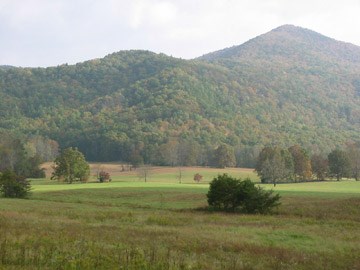
NPS photo. One landscape that’s seen a lot of changes is Cades Cove. The Cherokee used the Cove as a hunting ground, but after they were forced off of their lands in the early 1800s, the first settlers of European descent established themselves as small subsistence farmers. The Cove became a patchwork of crops such as corn, beans, squash, tomatoes, and wheat. The farmers also ditched and drained wetlands to create their fields, changing the ecosystem. The Park Service gradually acquired these farms from the landowners starting in the 1920s. By the 1950s, to maintain the cultural landscape of mixed farm fields, Park managers leased portions for cattle grazing and hay production, and planted a hardy European grass called fescue. 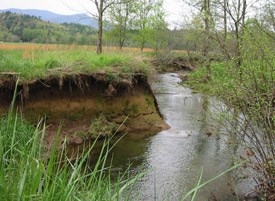
NPS photo. The fields of fescue characterized Cades Cove for many visitors: the green carpet rolled over hills and resembled a huge lawn or urban park. But there were two problems: it did not preserve an historic farm landscape, which was the original goal and it was a monocrop (single species crop) introduced into the park that did not provide varied habitats or food sources for turkey, coyote, fox, rabbit, deer, bear, ground nesting birds such as quail that the Cove had previously supported. In the late 1990s the cattle and hay leases expired, allowing park managers to experiment with planting native grass seeds and restoring wetlands. By doing so, they would also build a native seed bank that would allow managers to replant sections of disturbed land along the Foothills Parkway and in other areas of construction. To begin the restoration, vegetation managers including Kristine Johnson and Steven Shaper planned a new “farmed” landscape of native, warm-season forbs and grasses. Since 2002 Steven Shaper has been in the field heading up this multi-year project to harvest seeds from remaining small bunches of native plants, grow them in seed production fields, and use that seed to plant mixed batches to ensure a mixed-grass habitat. The production is much like farming, only what they harvest are different grasses and forbs instead of crops to sell. Each morning, vegetation managers meet in the pre-dawn at the Vegetation building near the Sugarlands Visitor Center to prioritize projects for that day and divide the work among team members. On the days that managers go to Cades Cove, Steven heads out with a crew of seasonal employees, often college or graduate students interested in vegetation management. They drive to Hyatt Lane or to the fields of Indian Grass that wag their seed-laden heads near the Cades Cove Visitor Center. What the crew does when they arrive varies by the season. The months in the seasons listed below can overlap, because managers plant and harvest according to temperature and precipitation rather than the calendar. 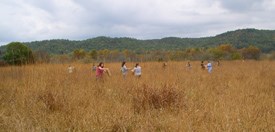
NPS photo. Fall Seed Harvesting. In Cades Cove, just west of Hyatt Lane, 15 planted acres of increase fields (seed production areas) wave with seed-heavy heads in the fall breeze. The very first harvests of native seeds were in small patches of remaining native grasses. Now, Steven and his crew use a tractor and brush to skim delicate seeds off of Indian Grass (Sorghastrum nutans), move in pairs along rows of native bush clover (genus Lespedeza—there are native and non-native species of this in the park), and walk nearby to planted rows of wild quinine (Parthenium integrifolium). They also harvest little blue stem (Schizachyrium scoparium) and gamma grass (Tripsacum dactyloides). Frequently, volunteers--such as those pictured above from Gatlinburg’s Pi Beta Phi middle school--help to harvest seeds by hand. The 2014 fall seed harvest produced 229 pounds of bulk seed. 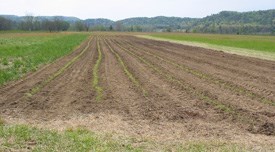
NPS photo. What are the results of all this work? In Cades Cove, just west of Hyatt Lane, 15 planted acres of increase fields (seed production areas) wave with seed-heavy heads in the fall breeze. Last spring managers planted 13,462 live plants of six different species of forbs and grasses. In the fall, they planted a plot of Virginia wild rye, a native “cool season” annual grass that will produce seeds to re-vegetate the Foothills Parkway and other park landscapes. Seed harvests in 2007 yielded 350 pounds of bulk seed, which was lower than in past years due to severe drought. The 2008 harvest was much bigger--1,400 pounds--because of frequent rains in the spring and summer. Cherie and Steven are already planting some of these seeds in the park’s greenhouse, where they will sprout and wait for warmer months. Since 2004, the efforts of these vegetation managers have added 14 acres of mixed native-species meadow habitat to Cades Cove. Exotic plant management also continues, with success in controlling lespedeza, multiflora rose, honeysuckle and privet in the meadows. Some landscapes will still be mowed so visitors will see the rolling fields to which they have grown accustomed. Other landscapes are burnt, plowed, and harvested in the gradual process to restore most of the Cove to native meadow habitat. 
NPS photo. 
NPS photo. 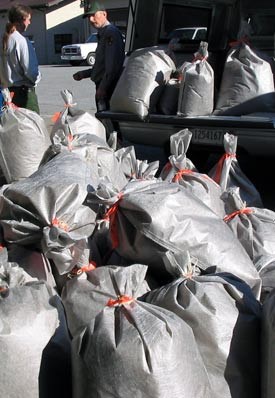
NPS photo. Winter Seed drying and cleaning, plug propagation, and controlled burning. When Steven and his crew come in from the fields with their huge cloth sacks stuffed full of seed, they store it in piles to air dry. These piles of downy fluff can be as big as five feet across and three feet high. Seed is then cleaned and stored for planting using a no-till seed drill pulled behind a tractor. 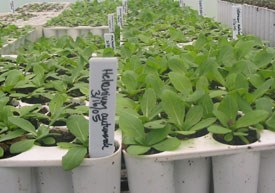
NPS photo. Late winter is also time for prescribed burns. Vegetation managers began “rotational burning,” which means burning each field every three years in a cycle, in 2003. The regular fires scorch the invasive species and return them to the earth as nutrients, and regenerate the native grasses that evolved with lightning- and human-set fires. Spring Sowing seed. When the winds are warm and the soil begins to thaw, it’s time to plant the seeds with the no-till drill-planting. The goal of providing mixed, self-regenerating habitat for insects, birds, and animals is well under way. 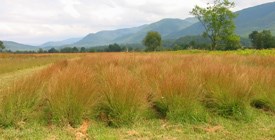
NPS photo. Summer Exotic plant, insect, and animal control. There is a lot of work to be done to control invasive plants and to stop rooting hogs and savagely biting fire ants. In the summer, while the blades soak up sun in the long days, Steven and his crew eradicate oriental bittersweet, privet, multiflora rose, non-native species of Lespedeza, and many other plants. They also keep an eye out for signs of introduced hogs, which root out native plants, and for the huge fire ant mounts whose occupants pose a safety risk to people and ground nesting animals. What are the results of all this work? Since 2004, the efforts of these vegetation managers have added 25 acres of mixed native-species meadow habitat to Cades Cove. Exotic plant management also continues, with success in controlling lespedeza, multiflora rose, honeysuckle and privet in the meadows. Some landscapes will still be mowed so visitors will see the rolling fields to which they have grown accustomed. Other landscapes are burnt, plowed, and harvested in the gradual process to restore most of the Cove to native meadow habitat. |
Last updated: October 23, 2015
